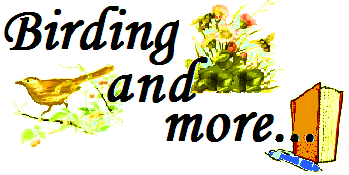 Newsletter
Newsletter
2010
/ Issue 5
IN THIS ISSUE: QUINTE AREA DUCKS, GEESE, AND SWANS
DUCKS, GEESE, AND SWANS
 Canada
Geese and Mallards are everywhere. It's also easy to see Mute Swans and
Tundra Swans. There
Canada
Geese and Mallards are everywhere. It's also easy to see Mute Swans and
Tundra Swans. There
 are
Mallards, Mergansers, and Goldeneyes on the Moira River. There are
Long-tailed Ducks and Red-breasted Mergansers in Wellington Harbour.
Presqu'ile Park is bragging that they have Wood Ducks, American Wigeons,
Northern Pintails, Greater Scaup and Lesser Scaup. East Lake has
Redheads, Ring-necked Ducks, Scaup, Goldeneye, and Buffleheads. Kaiser
Crossroads has
are
Mallards, Mergansers, and Goldeneyes on the Moira River. There are
Long-tailed Ducks and Red-breasted Mergansers in Wellington Harbour.
Presqu'ile Park is bragging that they have Wood Ducks, American Wigeons,
Northern Pintails, Greater Scaup and Lesser Scaup. East Lake has
Redheads, Ring-necked Ducks, Scaup, Goldeneye, and Buffleheads. Kaiser
Crossroads has
 seen
Buffleheads, Northern Pintails, and American Wigeons, and Prince Edward
Point features White-winged
seen
Buffleheads, Northern Pintails, and American Wigeons, and Prince Edward
Point features White-winged
 Scoters,
Long-tails, Buffleheads, and a variety of Mergansers. So this is the
time to get out to the open waters and take in your fill.
Scoters,
Long-tails, Buffleheads, and a variety of Mergansers. So this is the
time to get out to the open waters and take in your fill.The Ducks, Geese and Swans are waiting.
Picture
of the week
Long-tailed Duck (female)
From the
Birds in the Wild gallery on our website
THE READER'S PATCH
The Readers
Patch is
a space for your photos, stories, and/or comments.
Send anything
you'd like to share with us to: newsletter@birdingandmore.com
A Duck's feet have only very tiny capillaries in a lace-like structure. Warm blood flows from the body and criss-crosses with the colder blood coming up from the feet. The hot and cold capillaries exchange heat which preserves the Duck's core temperature.

This means that a duck's feet never feel the cold, even if they swim in icy cold water.
.
What's
New this week
at www.birdingandmore.com
New posts have
been added to
the Birding and more
blog:
New
pictures were added to the Birds
in the Wild gallery and the
Landscapes gallery.
A new page has been added to the site, called: Ten Tips for Successful Birding.
BROWN PELICAN

Taken in front of the Santa Cruz Beach Boardwalk
by a friend of Paula's
"You never know what might be around the next corner."
There's an old saying amongst birders: "One bird landing is worth a dozen taking off". OK, it's not an old saying. In fact, I just made it up, but it is true. If I'm lucky enough to be somewhere when a bird lands, I'm usually going to get a good look and probably a good photo. If I scare off a dozen birds by blundering into a place where they were just perched, I'm going to get a very brief glimpse of their backsides as they fly away - and I will almost never get a photo of them.
I've learned that whenever I'm walking through the woods and I come to a bend in the trail, I am best served to slow down and try to get a peek around the corner before I keep going and scare off whatever might be there. It happened so many times to me when I first started birding. I would come striding into a clearing, or make a fast turn only to see what would have been the best bird of the day fly off. Conversely, recently I have been fortunate enough to get some great photos by being patient and taking my time when hiking in the bush.
So next time you're out and about, remember to slow down a little. It'll increase the chances for those special sightings. Good luck and good birding!
With the warm weather we've had this past week, it's really beginning to feel like Spring and we see signs everywhere that's it just around the corner. We aren't ready quite yet to remove our “winter” feeder arrangement for “spring/summer” but since the snow is gone and chances are that very little will come now, we've hung a couple of feeders on the double hook in the back flower island. (For the winter we kept everything closer to the house to make it easier to put out the seed.) Almost instantly Chickadees were swooping in to grab a bite and I'm sure the Cardinals will be visiting them soon.
 While we prefer to have the birds coming closer to the house we like to give them options and provide for the ones who don't feel comfortable too close to people. There's been a nice variety and number of birds the past few days which is a real treat and hopefully a taste of what the
Summer will be like.
While we prefer to have the birds coming closer to the house we like to give them options and provide for the ones who don't feel comfortable too close to people. There's been a nice variety and number of birds the past few days which is a real treat and hopefully a taste of what the
Summer will be like.
With this Spring mood in the air, I'm beginning to think about soon pruning the shrubs that need to be pruned before flowering, in late
Winter/early Spring. Most of the shrubs we've chosen will flower in early to mid Spring followed by fruit later, and while some require very little pruning
(if any) some do require heavy pruning. In particular I'll have to cut back the
Butterfly Bush
If you liked our newsletter
please pass it along to your friends and family.
Subscriptions are free! Just send an
email to: newsletter@birdingandmore.com
If you wish to cancel your subscription send an email to unsubscribe@birdingandmore.com
